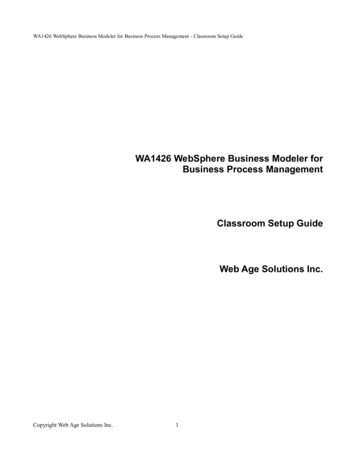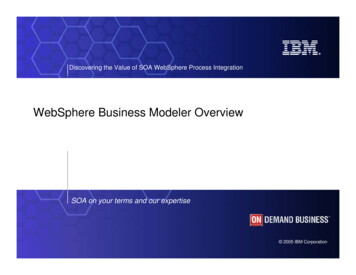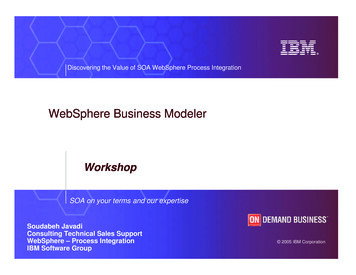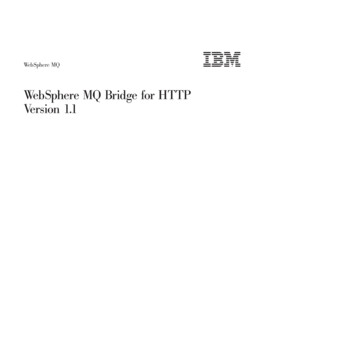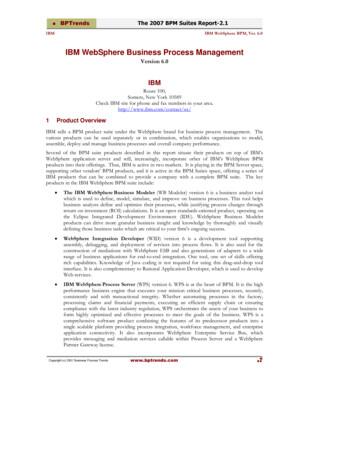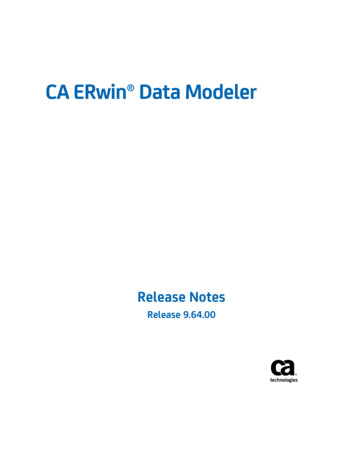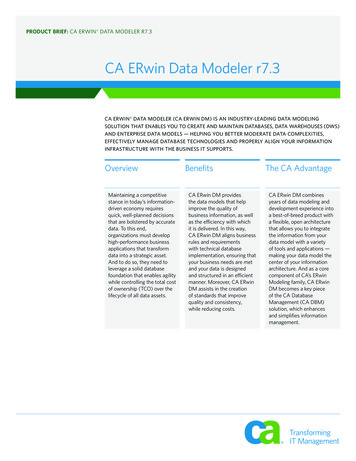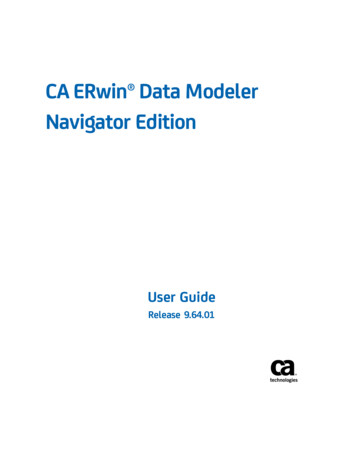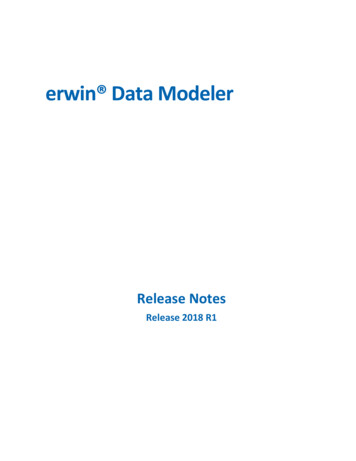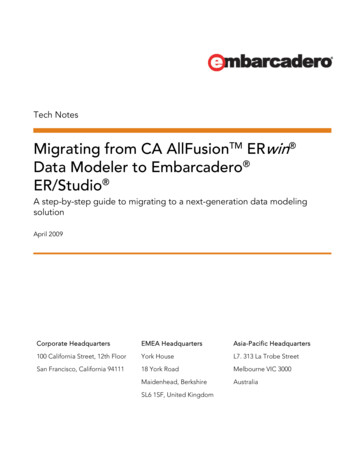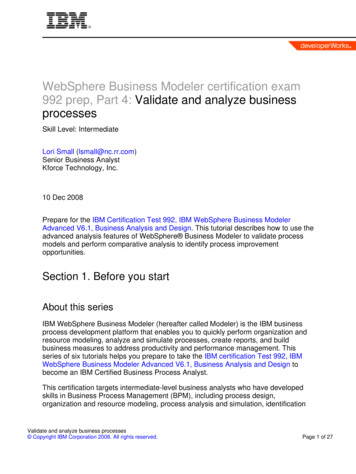
Transcription
WebSphere Business Modeler certification exam992 prep, Part 4: Validate and analyze businessprocessesSkill Level: IntermediateLori Small (lsmall@nc.rr.com)Senior Business AnalystKforce Technology, Inc.10 Dec 2008Prepare for the IBM Certification Test 992, IBM WebSphere Business ModelerAdvanced V6.1, Business Analysis and Design. This tutorial describes how to use theadvanced analysis features of WebSphere Business Modeler to validate processmodels and perform comparative analysis to identify process improvementopportunities.Section 1. Before you startAbout this seriesIBM WebSphere Business Modeler (hereafter called Modeler) is the IBM businessprocess development platform that enables you to quickly perform organization andresource modeling, analyze and simulate processes, create reports, and buildbusiness measures to address productivity and performance management. Thisseries of six tutorials helps you prepare to take the IBM certification Test 992, IBMWebSphere Business Modeler Advanced V6.1, Business Analysis and Design tobecome an IBM Certified Business Process Analyst.This certification targets intermediate-level business analysts who have developedskills in Business Process Management (BPM), including process design,organization and resource modeling, process analysis and simulation, identificationValidate and analyze business processes Copyright IBM Corporation 2008. All rights reserved.Page 1 of 27
developerWorks ibm.com/developerWorksof business measures to address productivity and performance management andgenerate reports. It is expected that they will be able to perform the tasks involved inthe role independently, with limited assistance from peers, product documentationand vendor support services.About this tutorialThis tutorial is the fourth in the series designed to help you prepare for the IBMCertification Test 992: IBM WebSphere Business Modeler Advanced V6.1, BusinessAnalysis and Design. This tutorial explains how to use the simulation results fromPart 3 to validate process flow within the model, and how to apply comparisonfeatures to evaluate the impact of change to the model. You'll learn about evaluatingprocess time and identifying potential process bottlenecks. You'll also learn how toidentify process improvement opportunities, analyze associated costs and resourceallocation, and validate that a model meets requirements. After you complete thistutorial, continue with the fifth tutorial, which covers the query and reporting featuresthat are included with the tool.PrerequisitesThis tutorial is written for analysts whose skills and experience are at anintermediate to advanced level. You should have a general familiarity with using anintegrated development environment.System requirementsTo run the examples in this tutorial, you need to install WebSphere BusinessModeler Software V6.1. Download a free trial version of WebSphere BusinessModeler if you don't already have a copy of it. You can find the hardware andsoftware requirements for Modeler at WebSphere Business Modeler Advanced:System Requirements.Section 2. Validating the process modelIsolating business issuesWhy model? We know that business processes can break down for various reasonsValidate and analyze business processesPage 2 of 27 Copyright IBM Corporation 2008. All rights reserved.
ibm.com/developerWorksdeveloperWorks that can be difficult to isolate and identify. Modeling and simulating the processescan reduce complexity by highlighting areas with known problems, including: Multiple iterations High costs Long process delays Limited or surplus resources BottlenecksIn Part 2 of this series, we discussed business process reengineering, and its focuson streamlining and automating processes to achieve business goals moreefficiently. You saw how a business analyst can use Modeler to capture the existingbusiness environment and model the proposed process changes. Overall, thesemodeling efforts help you understand the big picture, and more easily communicatewhat needs to be accomplished to the relevant stakeholders.The most difficult aspect of process modeling involves understanding the businesscontext -- the business objectives and how to define metrics to ensure the goals arebeing realized. Even the most seasoned business analyst will need to visualizemultiple scenarios to better understand how a process can be optimized.In Part 3, you learned about Modeler's simulation environment and how to enhancethe high-level process model with underlying business data. We also discussed thesimulation features, and how to control the runtime attributes so you can simulateand analyze your processes under various conditions. This lets you essentiallypreview how a process will perform in a real-life work environment.In this tutorial, you'll learn how to use Modeler to: Validate and debug the process flow Evaluate change to the model Identify process improvement opportunitiesProcess simulation recapAs discussed in Part 3, simulations provide two types of information aboutprocesses: Simulation statistics, which are generated while the simulation isrunning.Validate and analyze business processes Copyright IBM Corporation 2008. All rights reserved.Page 3 of 27
developerWorks ibm.com/developerWorks Simulation results, which are compiled when the simulation hascompleted.Physically watching the animated process helps you visualize task bottleneckswhere tokens accumulate in the queue. Once a simulation is complete, the resultscan be evaluated and the process can be revised accordingly to achieve the mosteffective execution. The simulation results represent details about the process as awhole, as well as the individual tasks and connections in the process. Analyzing theresults can help identify resource usage issues, including process revenues, costs,and profits.The Processes view contains data relating to the simulated process, including starttimes, revenues, costs, and profits. The Tasks view has statistics relating to tasksperformed within the process, including the current number of active instances ofeach task, and cumulative cost, revenue, and profit for each task. The Connectionsview shows the quantity of tokens transferred between each activity in the process.The Connections view can provide information regarding path traversal, such asidentifying which paths are under-utilized.We'll demonstrate by using the imported Quickstart Finance sample that is shippedwith Modeler. This sample includes simulation snapshots for the To Be LoanApplication process.Quickstart Finance case study: Simulation reviewAfter you have imported the Quickstart Finance sample project, open the firstsimulation profile in the first simulation snapshot, as shown in Figure 1.Figure 1. Quickstart Finance simulation profileValidate and analyze business processesPage 4 of 27 Copyright IBM Corporation 2008. All rights reserved.
ibm.com/developerWorksdeveloperWorks Set the token creation attribute to 100 tokens, as shown in Figure 2.Figure 2. Set token creation attributeRun the simulation without animation and view the results. We chose to view theresults across all process instances. In Figure 3, note that the Tasks results showthat all tasks were activated at least once. This means the token setting wasadequate to activate all the process cases.Validate and analyze business processes Copyright IBM Corporation 2008. All rights reserved.Page 5 of 27
developerWorks ibm.com/developerWorksFigure 3. Quickstart Finance Tasks resultsWe can also confirm that all the connections were activated, as shown in Figure 4,which further validates the token creation setting.Figure 4. Quickstart Finance Connections resultsVisual analysis of the simulation results can be helpful in identifying process issues,but Modeler also includes advanced analysis and validation features. Next, we'lldiscuss these features and how they can be used to provide targeted and moredetailed model analysis.Analyzing the process modelModeler supports multiple ways to investigate different aspects of your business andits processes, to gather information on current state, and to evaluate proposedchanges. After initial validation resulting in an error-free process, you can performseveral types of additional analysis on the model elements that you have created ina project, on simulation profiles, and on simulation results as follows: Static analysis is used to examine specific details of the contents of yourValidate and analyze business processesPage 6 of 27 Copyright IBM Corporation 2008. All rights reserved.
ibm.com/developerWorksdeveloperWorks modeling projects. Profile analysis is used to review the details of a simulation profile. Dynamic analysis is used to evaluate the simulation results generatedafter you run a simulation.Each of these analysis categories is explained in more detail in the rest of thistutorial.Section 3. Static analysisModeler provides a variety of static analysis functions that let you extract specifictypes of important business information from your models. Static analysis canprovide relative costs for multiple scenarios, but, most importantly, it provides ameans of validating your model prior to simulation.The static analysis functions are: Process model analysis functions, which includes functions relating toprocess models in their static state. Organization model analysis, which includes two analysis functions fororganization models that allow you to identify the usage and position oforganization model elements within structures and structure definitions. Resource model analysis, which includes functions that extractinformation on resources, roles, and timetables that you have defined inyour project. Element Type analysis , which includes three types of general analysisfunctions used to determine the relationships between model elements.Process model analysisProcess model analysis provides information on the contents of a specific processmodel, and includes the functions in the following table.Table 1. Process model analysis functionsFunctionDescriptionActivities by classifier analysisReturns the activities of the process that areassociated with each classifier value of selectedclassifiers.Validate and analyze business processes Copyright IBM Corporation 2008. All rights reserved.Page 7 of 27
developerWorks ibm.com/developerWorksActivities by location analysisReturns the activities of the process that areperformed at each location.Activities by organization unit analysisReturns the activities of the process that areperformed by each organization unit.Activity cost and duration analysisReturns the cost of each activity as a sum of theaverage costs of the allocated resources. It alsocomputes the total working duration of theallocated resources of each activity, and theminimum working duration of the activity.Activities unable to start analysisReturns a list of the activities of the process thatcannot start.Activity resource and role leveling analysisCompares the number of required resources orroles to the number of available resources orroles for each activity in the process.Activity throughput analysisDetermines the number of times that eachactivity in a process can deliver output in an hour.Input and output paths analysisDisplays a list of paths in a process that lead toor from an element that you select.Path cycles analysisReturns a list of the paths in a process that havea closed loop of connectors and activities.Paths unable to be followed analysisReturns a list of the paths in the process thatcannot be followed because of an invalid inputcriterion on an activity in the path.Organization model analysisThe following organization model analysis functions are provided:Table 2. Organizational model analysis functionsFunctionDescriptionEntity structure analysisShows the position of a selected entity in thestructures that you have defined.Type structure analysisShows the position of a selected type in thestructure definitions that you have defined.Resource model analysisResource model analysis is a major aspect of analyzing processes becauseresources are typically the primary generators of cost and duration in a process.The resource model analysis functions are:Validate and analyze business processesPage 8 of 27 Copyright IBM Corporation 2008. All rights reserved.
ibm.com/developerWorksdeveloperWorks Table 3. Resource model analysis functionsFunctionDescriptionQualified resource cost analysisDetermines the cost of one or more resourcesqualified for a particular role during a specifictime period.Qualified resources for role analysisShows the resources that are qualified to performone or more roles that you select for the analysis.Qualified resource availability analysisDetermines the periods during which one or morequalified resources is available to perform a role,beginning and ending with times that you specify.Qualified resource availability for durationanalysisDetermines the periods during which one or morequalified resources for a certain role is availablefor a specified duration from a specified starttime.Qualified resources costs summary analysisDetermines the costs of providing a role in allperiods during which qualified resources areavailable between a specified start and end time.Resource availability analysisDetermines the periods during which a selectedresource is available, beginning and ending withtimes that you specify.Resource availability for duration analysisDetermines the periods during which a selectedresource is available for a specified duration,starting from a specified time.Resource cost analysisDetermines the cost of a resource during aspecific time period.Resources costs summary analysisDetermines the costs of multiple resources for allperiods during which the resources are availablebetween a specified start and end time.Resource roles analysisShows the details of the role qualifications of oneor more resources.Role availability analysisDetermines the periods during which a selectedrole is available, beginning and ending with timesthat you specify.Role availability for duration analysisDetermines the periods during which a selectedrole is available for a specified duration, startingfrom a specified time.Role cost analysisDetermines the cost of a role during a specifictime period.Role costs summary analysisDetermines the costs of multiple roles for allperiods during which the roles are availablebetween a specified start and end time.Element type analysisValidate and analyze business processes Copyright IBM Corporation 2008. All rights reserved.Page 9 of 27
developerWorks ibm.com/developerWorksThe element type analysis functions are:Table 4. Element type analysis functionsFunctionDescriptionType instance matching analysisShows all the instances of a selected modelelement type that provides a type definition.Type instance matching matrix analysisAllows you to view all the instances of aparticular model element that provides a typedefinition that you have created within a project.Model element association matrix analysisShows the associations between two types ofmodel elements.Note: Some of the static analysis functions are available from the process diagramcontext menu (right-click the process editor background as shown in Figure 7), whileothers are only available from the project tree context menu (right-click the processnode in the project tree). In other words, if you can't find a particular function, tryusing a different context menu.Quickstart Finance case study: Performing static analysesOpen the As Is Loan Application process and change the Resources value for theReview Loan Application task from 30 minutes to 30 hours, as shown in Figure 5.Figure 5. Quickstart Finance - Define resourceValidate and analyze business processesPage 10 of 27 Copyright IBM Corporation 2008. All rights reserved.
ibm.com/developerWorksdeveloperWorks As you can see, Kim Lee is an individual resource and is the only one assigned tothis task, which will create a major backlog in the process. Create a simulationsnapshot and open the simulation profile. Increase the total number of tokenscreated to 100. Simulate the process with animation and notice the high number oftokens waiting to be processed in the Review Loan Application task, as shown inFigure 6. You can see this occurring in both the process diagram and the resultsview.Figure 6. Quickstart Finance – Animated simulation statisticsValidate and analyze business processes Copyright IBM Corporation 2008. All rights reserved.Page 11 of 27
developerWorks ibm.com/developerWorksWe could also have used the activity throughput static analysis function to identifythe bottleneck, as shown in Figure 7, but this would only be relevant if we changedthe activity processing time to 30 hours. We changed the resource time andconfigured the simulation to use the resource time as the task processing time. Asdescribed in Part 3, simulation settings can be configured globally, at the snapshotor process profile scope.Figure 7. Quickstart Finance – Static analysis activity throughputValidate and analyze business processesPage 12 of 27 Copyright IBM Corporation 2008. All rights reserved.
ibm.com/developerWorksdeveloperWorks Useful pre-simulation static analysis functionsSome recommended static analysis tests to use prior to simulating a process areActivity unable to start and Paths unable to be followed. The Activity unable tostart analysis helps determine whether you have sufficient resources available,whether the input definitions are adequate, or whether some general syntacticalerrors exist in the process flow. The Paths unable to be followed analysis helpsidentify process cases that won't be executed during simulation. This is often causedby invalid probability definitions on choice elements. Note that the analysis resultsview highlights the relevant path and activities in the diagram editor for easyidentification.A resource leveling exerciseNow let's look at how to determine whether sufficient resources are available for aValidate and analyze business processes Copyright IBM Corporation 2008. All rights reserved.Page 13 of 27
developerWorks ibm.com/developerWorksparticular process simulation. Complete the following steps to explore therelationship between a role and qualified individual resources:1.Open the Loan Application (As Is) process for the Quickstart Financesample that is shipped with Modeler, and revise the Resources value forthe Review Loan Application task, as shown in Figure 8. It has a singleindividual resource, Kim Lee, who is qualified as the Team Lead role.2.Add another role requirement for a Team Lead and set the Quantity to 2units. This requires that the Review Loan Application task has twoindividual resources available of role type Team Lead before it can start.Figure 8. Quickstart Finance - Resource role definition3.Open the process, select the palette (as opposed to a specific processelement), and select Static Analysis Activities Unable to Start. Asshown in Figure 9, you should see that the Review Loan Applicationactivity is listed in the results window stating that there are not enoughresource units available. If you change the role quantity to 1 or create anValidate and analyze business processesPage 14 of 27 Copyright IBM Corporation 2008. All rights reserved.
ibm.com/developerWorksdeveloperWorks additional individual resource of role type Team Lead and reanalyze, theresult will be empty, since adequate resources are now available to beginthe task.Note: If you want to simulate the revised process at this point, you should create anew simulation snapshot in order to include the changes you have made to theunderlying process attributes.Figure 9. Quickstart Finance static analysis - Activities unable to start analysisFor a full description of the types of static analysis and how to access each function,refer to the "Static analysis" topic in the Mod
To run the examples in this tutorial, you need to install WebSphere Business Modeler Software V6.1. Download a free trial version of WebSphere Business Modeler if you don't already have a copy of it. You can find the hardware and software requirements for Modeler at WebSphere B
